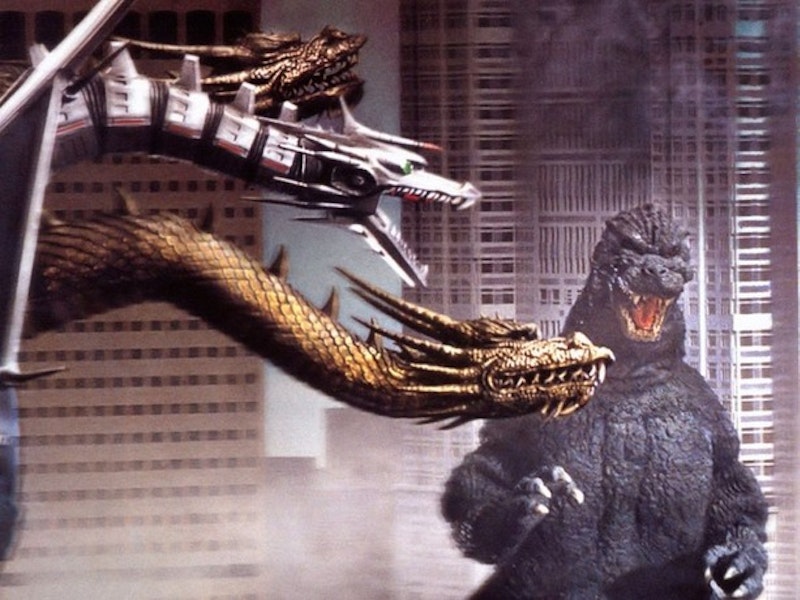In 1991 the Godzilla franchise was still looking to regain its footing. A reboot in 1984 was followed by five years of silence before the mediocre box office of Godzilla vs. Biollante. Two years later, Toho followed that film with something they thought would be more predictable: Godzilla vs. King Ghidorah. “More predictable” in the context of Godzilla means time travel, UFOs, and a killer robot. Everything’s relative.
As writer Kenichiro Terasawa (Kosuke Toyohara) investigates reports from World War Two of a dinosaur who defended Japanese troops and was later mutated by nuclear radiation into Godzilla (a returning Kenpachiro Satsuma), a UFO lands in Japan. The pilots (Chuck Wilson, Richard Berger, and Anna Nakagawa) claim to be representatives of the world government of the 23rd century, who want to rewrite history for the better by traveling further back in time and erasing Godzilla. But all is not what it seems, and it turns out that these benevolent time travelers are really trying to prevent the rise of Japan to global pre-eminence, not only eliminating Godzilla but creating a three-headed mutant monstrosity named King Ghidorah (Hurricane Ryu).
Kazuki Omori returns as director and scriptwriter. Veteran producer Tomoyuki Tanaka, co-creator of Godzilla, had to step back from this installment due to ill health after 30 years, replaced by Shogo Tomiyama. Tomiyama wanted to return aiming at young audiences and add a greater sense of fantasy to Godzilla, but Omori had already rejected Tanaka’s desire to have Ghidorah be discovered on Venus because he didn’t want aliens. Omori believed that Godzilla vs. Biollante had been beaten at the box office by Back to the Future II because time travel appealed to young people. Thus Godzilla vs. King Ghidorah.
You can see in this movie how pop culture was bouncing back and forth across the Pacific in the early-1990s. While North Americans had begun to assimilate anime, and manga influences were creeping into American comic books, Godzilla vs. King Ghidorah turned into a pastiche of American time travel movies. You particularly notice the killer robot from the future (Robert Scott Field), in the form of a white guy with a high forehead, who’s first a sinister opponent of the heroes and then, after a quick reprogramming, their ally. Derivative of the T-800, he’s not at all interesting in his own right.
Good artists borrow, great artists steal, entertainers copy. And often poorly. The Godzilla movies are like American super-hero comics in this way: they take whatever’s dominating popular culture, and figure out a way to bend it to their idiom. In this case, though, the time-travel story’s only partially digested. The movie’s a low-rent version of Star Trek in a way that the Godzilla movies of the 1960s and 70s avoided.
That’s not to say that the cheapness of the film is a problem. The problem is it’s not cheap enough. There’s a blandness to the cinematography, excepting effects director Koichi Kawakita’s kaiju fights, that feels like low-budget TV. There’s the occasional nice moment, as when tanks approach the UFO through morning mist or a time-travel scene is accompanied by a brief light show, but for the most part one misses the bright colors of yesteryear. The puppets playing genetically-modified pets named dorats are particularly poor, out of whack with the rest of the film.
The uncertain tone isn’t helped by the contradictions in the time-travel story, in which Godzilla’s still remembered by characters after he’s erased from history. But the story’s also not shaped by much of anything Godzilla actually does. He’s a piece of plot, shuffled here and there by the manipulations of others.
And there’s a nationalistic subtext that, to me, sits oddly with the franchise’s core themes. Not only is a proto-Godzilla depicted as taking sides in a human war on the side of the Japanese, but Japan’s role in the war is depicted uncritically. The generation that fought the war are valorized as men who built an economic powerhouse, which the movie imagines extending into the future. The blithe mention of Japan “acquiring” Africa and South America raises uncomfortable questions the movie’s not interested in.
It’s not unusual for a Godzilla movie to revolve around sinister alien forces threatening Japan. Usually the aliens are just that, and the metaphor remains metaphor. Having Japan menaced by Caucasians trying to undo a Japanese economic miracle feels a bit on the nose. There’s a fine line between defending a country and fighting for its glory, and you’re not too sure which it is you’re seeing in this movie. The Godzilla films have never been subtle, with a central metaphor the size of a skyscraper, but usually there’s a skepticism of war and by extension nationalism near the heart of the movies. That’s less true here.
Still, the sheer weirdness of the film works in its favor. Time travel, giant monsters, superstrong robots and mutated future pets make for a heady blend. When the movie gets going, it produces the kind of genre thrills you want.
At its best, the film hits on moments that’re like a 1990s equivalent to the camp weirdness of 1960s Godzilla. But that’s a difficult target to hit consistently. You can see this movie’s given up the attempts at darkness and realism that marked the last two entries in the series, a choice that led to box-office success. The movie’s a commercial film that made money. The nice thing about the Godzilla movies is that when they work, it’s typically through overloading their story with a specific kind of lunacy.

